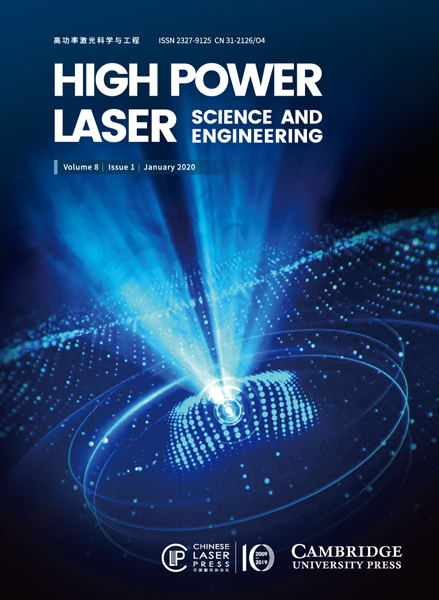2014, 2(3) Column
High Power Laser Science and Engineering 第2卷 第3期
A diode-pumped master oscillator power amplifier system based on a cryogenic Yb:YAG active-mirror laser has been developed. The performances of the laser amplifier at low temperature and room temperature have been investigated theoretically and experimentally. A maximum output energy of 3.05 J with an optical-to-optical efficiency of 14.7% has been achieved by using the master amplifier system.
diode-pumped solid-state laser Yb:YAG The laser system PALS, as a driver of a broad-beam ion source, delivered deuterons which generated neutrons with energies higher than 14 MeV through the 7Li(d, n)8Be reaction. Deuterons with sub-MeV energy were accelerated from the front surface of a massive CD2 target in the backward direction with respect to the laser beam vector. Simultaneously, neutrons were emitted from the primary CD2 target and a secondary LiF catcher. The total maximum measured neutron yield from 2D(d, n)3He, 7Li(d, n)8Be, 12C(d, n)13N reactions was ~3.5(±0.5) × 108 neutrons/shot.
beam-target fusion deuterons laser ion sources lithium neutrons The development, the underlying technology and the current status of the fully diode-pumped solid-state laser system POLARIS is reviewed. Currently, the POLARIS system delivers 4 J energy, 144 fs long laser pulses with an ultra-high temporal contrast of 5×1012 for the ASE, which is achieved using a so-called double chirped-pulse amplification scheme and cross-polarized wave generation pulse cleaning. By tightly focusing, the peak intensity exceeds 3.5×1020 W cm-2. These parameters predestine POLARIS as a scientific tool well suited for sophisticated experiments, as exemplified by presenting measurements of accelerated proton energies. Recently, an additional amplifier has been added to the laser chain. In the ramp-up phase, pulses from this amplifier are not yet compressed and have not yet reached the anticipated energy. Nevertheless, an output energy of 16.6 J has been achieved so far.
design high power laser laser amplifiers laser plasmas interaction laser systems modelling optimization ultra-intense ultrashort pulse laser interaction with matter In this paper we consider laser intensities greater than 1016 W cm?2 where the ablation pressure is negligible in comparison with the radiation pressure. The radiation pressure is caused by the ponderomotive force acting mainly on the electrons that are separated from the ions to create a double layer (DL). This DL is accelerated into the target, like a piston that pushes the matter in such a way that a shock wave is created. Here we discuss two novel ideas. Firstly, the transition domain between the relativistic and non-relativistic laser-induced shock waves. Our solution is based on relativistic hydrodynamics also for the above transition domain. The relativistic shock wave parameters, such as compression, pressure, shock wave and particle flow velocities, sound velocity and rarefaction wave velocity in the compressed target, and temperature are calculated. Secondly, we would like to use this transition domain for shockwave-induced ultrafast ignition of a pre-compressed target. The laser parameters for these purposes are calculated and the main advantages of this scheme are described. If this scheme is successful a new source of energy in large quantities may become feasible.
relativistic hydrodynamics shock waves laser plasma nuclear fusion fast ignition We present the first steps of a design of the optimal parameters for a full Bragg X-Ray free electron laser (BX-FEL). Aiming towards a future source of coherent X-ray radiation, operating in the strong Compton regime, we envisage the system to be the seed for an advanced light source or compact medical X-ray source. Here we focus on the design of the accelerator parameters: maximum gradient, optimal accelerated charge, maximum efficiency, and ‘wake coefficient’, which relates to the decelerating electric field generated due to the motion of a charged-line or train of charged-lines. Specifically, we demonstrate that the maximum efficiency has optimal value and given the fluence of the materials, the maximum accelerated charge in the train is constant. These two results might be important in any future design.
Bragg wake-field Compton scattering energy conversion efficiency fluence light source medical accelerator The properties of a series of phase measurement techniques, including interferometry, the Hartmann-Shack wavefront sensor, the knife-edge technique, and coherent diffraction imaging, are summarized and their performance in high power laser applications is compared. The advantages, disadvantages, and application ranges of each technique are discussed.
wavefront measurement phase retrieval focus prediction Ptychographical Iterative Engine A preliminary investigation on short-wavelength ablation mechanisms of poly(methyl methacrylate) (PMMA) and poly (1,4-phenylene ether ether-sulfone) (PPEES) by extreme ultraviolet (EUV) radiation at 13.5 nm using a table-top laserproduced plasma from a gas-puff target at LLG (Gottingen) and at 46.9 nm by a 10 Hz desktop capillary discharge laser operated at the Institute of Physics (Prague) is presented. Ablation of polymer materials is initiated by photoinduced polymer chain scissions. The ablation occurs due to the formation of volatile products by the EUV radiolysis removed as an ablation plume from the irradiated material into the vacuum. In general, cross-linking of polymer molecules can compete with the chain decomposition. Both processes may influence the efficiency and quality of micro(nano)structuring in polymer materials. Wavelength is a critical parameter to be taken into account when an EUV ablation process occurs, because different wavelengths result in different energy densities in the near-surface region of the polymer exposed to nanosecond pulses of intense EUV radiation.
EUV ablation organic polymer photo-erosion mechanisms wavelength effect The high repetition rate 10 J/10 ns Yb:YAG laser system and its key techniques are reported. The amplifiers in this system have a multi-pass V-shape structure and the heat in the amplifiers is removed by means of laminar water flow. In the main amplifier, the laser is four-pass, and an approximately 8.5 J/1 Hz/10 ns output is achieved in the primary test. The far-field of the output beam is approximately 10 times the diffraction limit. Because of the higher levels of amplified spontaneous emission (ASE) in the main amplifier, the output energy is lower than expected. At the end we discuss some measures that can improve the properties of the laser system.
Yb:YAG V-shape amplifier water-cooled 10 J laser system This paper reviews the different challenges that are encountered in the delivery of high power lasers as drivers for fusion energy. We will focus on diode-pumped solid-state lasers and we will highlight some of the main recent achievements when using ytterbium, cryogenic cooling and ceramic gain media. Apart from some existing fusion facilities and some military applications of diode-pumped solid-state lasers, we will show that diode-pumped solid-state lasers are scalable to inertial fusion energy (IFE)’s facility level and that the all-fiber laser scheme is very promising.
laser fusion energy high power lasers Nonlinear wake amplification by an active medium in a cylindrical waveguide using a modulated trigger bunch Download:581次
Download:581次
 Download:581次
Download:581次Cerenkov wake amplification can be used as an accelerating scheme, in which a trigger bunch of electrons propagating inside a cylindrical waveguide filled with an active medium generates an initial wake field. Due to the multiple reflections inside the waveguide, the wake may be amplified significantly more strongly than when propagating in a boundless medium. Sufficiently far away from the trigger bunch the wake, which travels with the same phase velocity as the bunch, reaches saturation and it can accelerate a second bunch of electrons trailing behind. For a CO2 gas mixture our numerical and analytical calculations indicate that a short saturation length and a high gradient can be achieved with a large waveguide radius filled with a high density of excited atoms and a trigger bunch that travels at a velocity slightly above the Cerenkov velocity. To obtain a stable level of saturated wake that will be suitable for particle acceleration, it is crucial to satisfy the single-mode resonance condition, which requires high accuracy in the waveguide radius and the ratio between the electron phase velocity and the Cerenkov velocity. For single-mode propagation our model indicates that it is feasible to obtain gradients as high as GV m?1 in a waveguide length of cm.
laser-plasma interaction novel optical material and device Beam alignment depends on CCD real-time image analysis and processing. In order to improve the quality of the alignment, multiple filters are used in far-field and near-field image processings. These multiple filters are constituted of an average filter and a median filter in different connection sequences, so that they can deal with different kinds of noise. To reduce the effect of the unknown nonlinear relationship between motor running steps and deviation pixels, a feasible methodology is offered to improve this phenomenon and a fuzzy algorithm is applied to the motor feedback control process. Because of the fuzzy control it is not necessary to establish an accurate mathematical model, so the impact of the nonlinear relationship will be reduced.
alignment fuzzy control image processing multiple filters The physical meaning and essence of Fresnel numbers are discussed, and two definitions of these numbers for offaxis optical systems are proposed. The universal Fresnel number is found to be N=(a2/λz)*C1+C2. The Rayleigh–Sommerfeld nonparaxial diffraction formula states that a simple analytical formula for the nonparaxial intensity distribution after a circular aperture can be obtained. Theoretical derivations and numerical calculations reveal that the first correction factor C1 is equal to cosθ and the second factor C2 is a function of the incident wavefront and the shape of the diffractive aperture. Finally, some diffraction phenomena in off-axis optical systems are explained by the off-axis Fresnel number.
correction factor off-axis Fresnel number off-axis optical system Rayleigh–Sommerfeld diffraction integral Laser-induced damage tests based on a marker-based watershed algorithm with gray control Download:691次
Download:691次
 Download:691次
Download:691次An effective damage test method based on a marker-based watershed algorithm with gray control (MWGC) is proposed to study the properties of damage induced by near-field laser irradiation for large-aperture laser facilities. Damage tests were performed on fused silica samples and information on the size of damage sites was obtained by this new algorithm, which can effectively suppress the issue of over-segmentation of images resulting from non-uniform illumination in darkfield imaging. Experimental analysis and results show that the lateral damage growth on the exit surface is exponential, and the number of damage sites decreases sharply with damage site size in the damage site distribution statistics. The average damage growth coefficients fitted according to the experimental results for Corning-7980 and Heraeus-Suprasil 312 samples at 351 nm are 1:10+(-)0:31 and 0:60+(-)0:09, respectively.
damage growth laser-induced damage marker-based watershed algorithm with gray control 动态信息
动态信息 丨 2023-06-21
HPL Highlight (Vol. 11, e40): NIF仍然是全球唯一一个能够进行ICF点火实验的装置动态信息 丨 2023-06-21
HPL Highlight (Vol. 11, e9): 变分神经网络预测激光尾波场加速电子能谱动态信息 丨 2023-06-21
HPL Highlight (Vol. 11, e7): 目标探测网络加入,激光等离子体加速器实现实时诊断动态信息 丨 2023-06-21
HPL Highlight (Vol. 11, e5): 910 nm波段超宽带种子源,向100 PW超强超短激光进发动态信息 丨 2023-06-21
HPL Highlight (Vol. 11, e4): 100 PW单束压缩!多步压缩器进阶双光栅激光评论微信公众号

点击菜单“联系编辑”即可添加期刊编辑为好友啦














